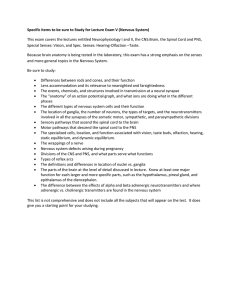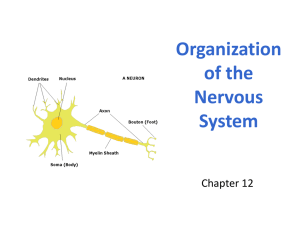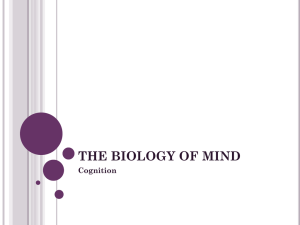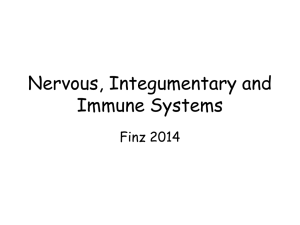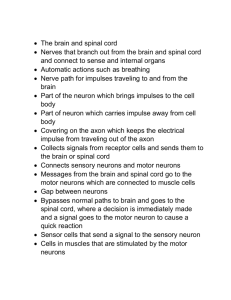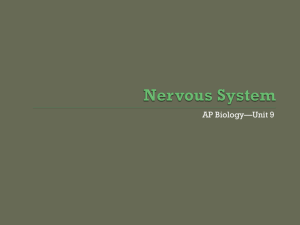all the neural tissue in the body.
advertisement
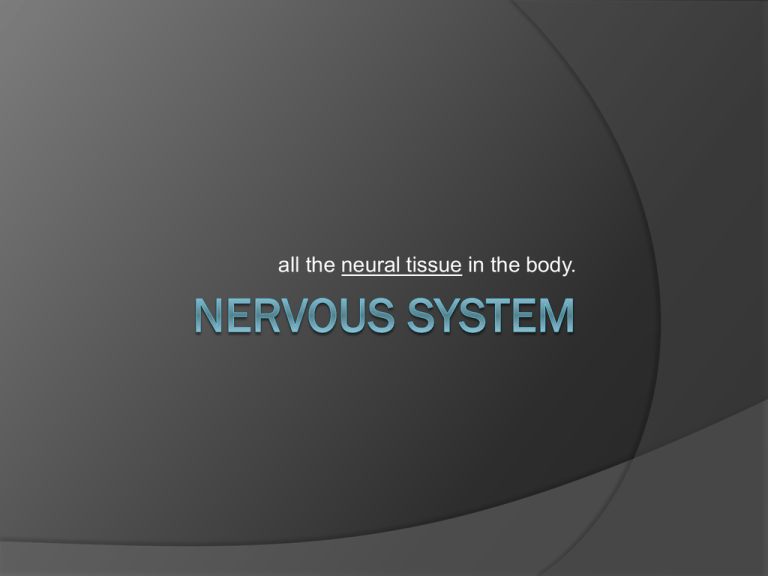
all the neural tissue in the body. Overview of the Nervous System Neural tissue contains 2 The organs of the nervous kinds of cells: system include: 1. neurons: the cells - the brain that send and receive - the spinal cord signals - sensory receptors of 2. neuroglia: the cells sense organs (eye, ears, that support and protect etc.) the neurons ○ - the nerves that connect the nervous system with other systems Overview of the Nervous System Neurons are the basic functional units of the nervous system. Anatomical Divisions Central Nervous System (CNS) Peripheral Nervous System (PNS) Sensory neurons bringing information to the brain through the PNS are afferent. Motor neurons carrying information from the CNS out through the PNS are efferent Central Nervous System The central nervous system (CNS) consists of the spinal cord and brain, which contain neural tissue, connective tissues and blood vessels. The CNS is responsible for processing and coordinating: sensory data from inside and outside the body. motor commands that control activities of organs such as the skeletal muscles. higher functions of the brain such as intelligence, memory, learning and emotion. Peripheral Nervous System The peripheral nervous system (PNS) includes all neural tissue outside the CNS. The PNS is responsible for: delivering sensory information to the CNS carrying motor command to peripheral tissues and systems Sensory information and motor commands in the PNS are carried by bundles of axons called peripheral nerves: 1. cranial nerves are connected to the brain 2. spinal nerves are attached to the spinal cord Functional Divisions of the PNS The efferent division, divided into: 1. the somatic nervous system (SNS), which controls skeletal muscle contractions ○ a. voluntary muscle contractions ○ b. involuntary muscle contractions (reflexes) Functional Divisions of the PNS The efferent division, divided into: 2. the autonomic nervous system (ANS), which controls subconscious actions such as contractions of smooth muscle and cardiac muscle, and glandular secretions. PNS distribution Dermatome Single bilateral (both sides of the body) region of skin surface monitored by a single pair of spinal nerves PNS distribution Peripheral neuropathies Regional loss of sensory and motor function Usually a result of trauma or compression ANS The ANS is separated into 2 divisions 1. the sympathetic division, which has a stimulating effect on all organs except digestive 2. the parasympathetic division, which has a relaxing effect on all organs except the digestive Neuron Structure Cell body large nucleus Cytoplasm and ribosomes that produce neurotransmitters. cytoskeleton; most nerve cells do not contain centrioles and cannot divide Neuron Structure several short, branched dendrites, and receive information from other neurons a long, single axon carries the electrical signal (action potential) to its target. axoplasm: the cytoplasm of the axon, The Synapse: critical area where one neuron communicates with another cell or neuron. Neurotransmitters Synaptic knob: synaptic vesicles filled with Neuromuscular junction chemical messengers Neuroglandular junction which affect receptors on the postsynaptic membrane Presynaptic cell: the neuron that sends the message Postsynaptic cell: the cell that receives the message Classification of Neurons Functional Classification of Neurons Sensory receptors are categorized as: Interoceptors: ○ monitor digestive, respiratory, cardiovascular, urinary and reproductive systems ○ provide internal senses of taste, deep pressure and pain Exteroceptors: ○ external senses of touch, temperature, and pressure ○ distance senses of sight, smell and hearing Proprioceptors: ○ monitor position and movement of skeletal muscles and joints Functional Classification of Neurons Sensory neurons or afferent neurons: collect information about our internal environment and our relationship to the external environment. Motor neurons or efferent neurons: carry instructions from the Central Nervous System the 2 major efferent systems are: the somatic nervous system (SNS), motor neurons that innervate skeletal muscles. the autonomic nervous system (ANS), motor neurons that innervate all other tissues: smooth muscle, cardiac muscle, glands & adipose tissue. Interneurons: in the brain and spinal cord responsible for distribution of sensory information and coordination of motor activity involved in higher functions such as memory, planning and learning the somatic nervous system (SNS), motor neurons that innervate skeletal muscles. the autonomic nervous system (ANS), motor neurons that innervate all other tissues: smooth muscle, cardiac muscle, glands & adipose tissue. Meninges of the Brain CSF: Cerebrospinal Fluid Cerebrospinal fluid: surrounds spinal cord and brain ○ Shock absorption, distributes materials (nutrients, waste, chemical messengers) Spinal tap: withdrawal of CSF via needle in lumbar region Neuroglia: CNS Ependymal cells o Line the canal of the spinal cord and ventricles of the brain, filled with circulating cerebrospinal fluid (CSF), o Some ependymal cells secrete cerebrospinal fluid, and some help circulate CSF. o Others monitor the CSF or contain stem cells for repair. Astrocytes ○ maintaining the blood-brain barrier that isolates the CNS ○ repairing damaged neural tissue Neuroglia: make up half the volume of the nervous system CNS Oligodendrocytes ○ wrap around axons to form insulating myelin sheaths: increases the speed of action potentials. ○ Because myelin is white, regions of the CNS that have many myelinated nerves are called white mater. ○ unmyelinated areas are called gray mater. Microglia ○ Microglia are small, with many fine-branched processes. They migrate through neural tissue, cleaning up cellular debris, waste products and pathogens. Play Video Transmembrane Potential all cells produce electrical signals by ion movements resting potential: the transmembrane potential of a resting cell graded potential: a temporary localized change in the resting potential, caused by a stimulus action potential: an electrical impulse (produced by the graded potential) that moves along the surface of an axon to a synapse. synaptic activity: the release of neurotransmitters, which produce graded potentials in a postsynaptic membrane. information processing: the response (integration of stimuli) of a postsynaptic cell. Passive Forces: chemical and electrical. Chemical gradients: concentration gradients of ions (Na+, K+) across the membrane Electrical gradients: the charges of + and - ions are separated across the membrane. + and - charges attract one another they will move to eliminate potential difference, resulting in an electrical current Electrochemical gradient: the sum of chemical and electrical forces acting on an ion (Na+, K+) chemical gradient of potassium tends to move potassium out of the cell, but the electrical gradient of the cell membrane opposes this movement the electrochemical gradient is a form of potential energy Transmembrane Potential Active Forces across the membrane Sodium potassium exchange pump Active forces maintain the cell membrane’s resting potential. The cell actively pumps out sodium ions (Na+), and pumps in potassium ions (K+). powered by ATP, exchanges 3 Na+ for each 2 K+, balancing the passive forces of diffusion. Changes in the Transmembrane Potential Passive Channels (leak channels): are always open, but their permeability changes according to conditions. Active Channels (gated channels): open and close in response to stimuli Chemically regulated channels Voltage-regulated channels Mechanically regulated channels Graded potentials Increasing sodium inside the cell produces a graded potential: Sodium ions enter the cell, raising the transmembrane potential. ○ Depolarization: shift in transmembrane potential toward 0 mV. The movement of sodium ions produces a local current that depolarizes nearby parts of the cell membrane. ○ The change in transmembrane potential depends on the stimulus. When the stimulus is removed, the transmembrane potential returns to normal (repolarization). Action Potential (6 step term) Threshold: depolarization big enough to open voltage regulated channels in the cell All-or-none principle: activates or not Generation of action potentials 1. Polarization (resting) 2. Depolarization to threshold (from stimulus) 3. Generation of an action potential (if depolarization is big enough) 4. Propagation of an action potential 5. Repolarization 6. The return to normal permeability (ion conditions restored) Propagation of Action Potentials During the time period from the beginning of the action potential to the return to resting state (the refractory period), the membrane will not respond normally to additional stimuli. Propagation of Action Potentials Axon diameter & propagation speed Type A fibers: (most important information) senses of position, balance and touch; and motor impulses to skeletal muscles ○ myelinated ○ large diameter ○ high speed (140 m/sec) Type B fibers: ○ myelinated ○ medium diameter ○ medium speed (18 m/sec) Type C fibers: ○ unmyelinated ○ small diameter ○ slow speed (1 m/sec) Synaptic Activity Synaptic Delay: The fewer synapses involved in relaying a message, the faster the response. Reflexes are important to survival because they may involve only one synapse Synaptic Fatigue: When a neurotransmitter cannot be recycled fast enough to meet the demand of an intense stimulus, synaptic fatigue occurs. The synapse becomes inactive until ACh is replenished. Activities of Other Neurotransmitters Norepinephrine CNS ○ Regulates normal brain processes PNS ○ Fight or flight Dopamine Inhibitory Produce arousal ○ Movement, cognition, pleasure, motivation Increased can cause schizophrenia, decreased can cause Parkinson’s disease Mimicked by : LSD Activities of Other Neurotransmitters Serotonin Associated with mood control, sleep, pain perception Low levels can cause depression and anxiety Increase with Carb consumption Mimicked by Prozac Gamma aminobutyric acid (GABA) Inhibitory (decrease anxiety, alertness, memory and tension) Mimicked Alcohol Neuromodulators Histamine ○ Increased wakefullness, stomach acid and itchiness ○ Decreased hunger ○ Blocked by benadryl Acetylcholine (Ach) ○ Increased muscle contractions and sweating ○ Decreased heart rate ○ Nicotine Glutamate ○ Common excitatory transmitter ○ Ketamine blocks it Opiods ○ ○ ○ ○ Modulate pain, reduce stress, calm Depress respiration/pulse Heroine and morphine Morphine, heroin How neurotransmitters work 1 of 3 ways Direct effect on the membrane potential Indirect effect on the membrane potential Lipid soluble gases that exert their effect on the inside of the cell Michael Jackson 50 Valium Ativan-sedative Versed-anesthetic Dipravan-anesthetic Heath Ledger 28 Oxycontin Hydrocodone Valium Xanax Restoril (sleep aid) Unisom Anna Nicole Smith 39 Chloral hydrate (sedative) Valium (sedative) Clonazepam, lorazepam, qazepam (sedatives) Benadryl Topaman (anti seizure) Whitney Houston 48 Cocaine Marijuana Xanax Muscle relaxant Flexeril Benadryl Brittany Murphy 32 hydrocodone acetaminophen Chlorpheniramine (antihistamine) L-methamphetamine (decongestant, vasodilator) Adam Goldstein (DJ AM) Heroine Overdoses Dee Dee Ramone (the Ramones) Robin Crosby (Ratt) Darby Crash (The Germs) Jim Morrison (the Doors) Pam Morrison (Jim’s wife) John Dougherty (Flipper/The Melvins) Pete Farndon (The Pretenders) Janis Joplin (solo) Bradley Nowell (Sublime) Kristen Pfaff (Hole) Sid Vicious (Sex Pistols) Hillel Slovak (Red Hot Chili Peppers) Layne Staley (Alice in Chains) Mike Starr (Alice in Chains) Giget Gein (Marilyn Manson) Johnny Thunders (New York Dolls) Other Overdoses John Belushi (heroine) Chris Farley (cocaine/morphine) Judy Garland (barbituates) Mitch Hedberg (heroine) Billy Mayes (cocaine) Big Moe (codeine/antihistamine) Marilyn Monroe (barbiturate) River Phoenix (heroine/cocaine) Elvis Presley (barbiturates) Hank Williams Sr (Morphine/alcohol) Amy Winehouse (alcohol) Spinal meninges Spinal meninges: series of specialized membranes surrounding the spinal cord Provide stability Shock absorption Blood vessels within these layers deliver O2 and nutrients Meningitis Bacterial or viral Spinal meninges Dura mater: tough, fibrous, forms outermost layer of the spinal cord Epidural space: space between dural mater and vertebral canal Arachnoid mater: middle meningeal layer Cerebrospinal fluid: surrounds spinal cord and brain ○ Shock absorption, distributes materials (nutrients, waste, chemical messengers) Spinal tap: withdrawal of CSF via needle in lumbar region Pia mater: innermost meningeal layer Anatomy of the Spinal cord Dorsal roots: axons of the dorsal root ganglia contain sensory neurons Ventral roots: pair of motor neuron axons that extend to the PNS Spinal nerve: distal (away) from the dorsal root ganglion, sensory and motor roots bind together Sectional Anatomy Organization Motor nuclei Issue motor commands to peripheral effectors Sensory nuclei Receive and relay sensory information from peripheral receptors Gray Mater Descending tracts Convey motor commands to the spinal chord Ascending tracts Carry sensory information toward the brain White mater Nerve plexuses Complex interwoven network of nerves Cervical plexus Brachial plexus Lumbar plexus Sacral plexus Reflexes: rapid automatic responses to specific stimuli 1. Arrival of stimulus and Reflex Arc: wiring of a single reflex (begins at a receptor and ends at a peripheral effector) activation of receptor 2. Activation of a sensory neuron 3. Information processing 4. Activation of a Motor Neuron 5. Response of a peripheral effector Classification of Reflexes Innate: form during development Withdrawal from pain, eye tracking Acquired: learned motor pattern Stepping on brakes, “gun” starts in track Somatic: involuntary control of muscular system Patellar reflex Visceral: (autonomic) control activities of other systems Pupils react together with light change Sensory receptors General senses Temperature Pain Touch Pressure Vibration Proprioception (awareness of your surroundings) Special senses Olfaction Vision Gustation Equilibrium Hearing Detection of stimuli Each type is more sensitive to a certain stimuli Most simple receptors are free nerve endings Area monitored by a single receptor is a receptive field When sensory information is sent to the CNS, it is directed to specific cortexes of the brain according to the stimuli Adaptation Reduction in the sensitivity when there is constant stimulus Nociceptors: pain receptors Fast pain: (Type A fibers) prickling pain Slow pain: (Type C fibers) burning or aching pain Other Types of Receptors Thermoreceptors Chemoreceptors; respond only to water soluble and lipid-soluble substances in surrounding fluid Mechanoreceptors Tactile; touch, pressure and vibration Bareoreceptors; pressure changes in walls of vessels Proprioceptors; positions of joints and muscles States of Consciousness Conscious; awareness and attention to external events Unconscious; range Deep sleep; body is relaxed low activity in cerebral cortex, low HR and respiration REM (rapid eye movement) sleep; increased activity similar to when you are awake but are less responsive to outside stimulus Periods without REM can lead to variety of mental function disturbances The Brain The brain is a large, delicate mass of neural tissue containing passageways and chambers filled with cerebrospinal fluid. Each of the five major regions of the brain has specific functions. As you move from the medulla oblongata to the cerebrum, those functions become more complex and variable. Conscious thought and intelligence are provided by the neural cortex of the cerebral hemispheres. The brain is isolated from general circulation by the blood-brain barrier. Functions by region Medulla Oblongata The medulla oblongata is continuous with the spinal cord. The medulla oblongata contains all of the tracts that allow the brain and spinal cord to communicate coordinates complex autonomic reflexes, and controls visceral functions. Pons: links Cerebellum, mesencephalon and cerebrum to spinal cord Areas of the brain Cerebellum: autonomic processing center. It has 2 primary functions: Adjusting the postural muscles of the body. Programming and fine tuning movements controlled at conscious & subconscious level Mesencephalon: receives visual & auditory input Diencephalon: integrates conscious and unconscious sensory information and motor commands. It contains the epithalamus, the thalamus, and the hypothalamus. Limbic System The limbic system is a functional grouping that includes: establishing emotional states linking conscious functions of the cerebral cortex with unconscious, autonomic functions of the brain stem facilitating memory storage and retrieval Memory Fact memories are specific bits of information such as the color of a stop sign or the smell of a perfume Skill memories are learned motor behaviors: light a match or tie shoelaces With repetition, skill memories become incorporated at the unconscious level. Ex: complex motor patterns involved in snow boarding or playing the violin Skill memories related to programmed behaviors, such as eating, are stored in appropriate portions of the brain stem. Complex skill memories involve the integration of motor patterns in the cerebral cortex, and cerebellum. Memory Two classes of memories are recognized. Short-term memories, do not last long, but while they persist the information can be recalled immediately. ○ Contain small bits of information, such as a person’s name or a telephone number. ○ Repeating information reinforces the original short-term memory and helps ensure its conversion to a long-term memory. Long-term memories last much longer, in some cases for an entire lifetime. Cerebrum The cerebrum is the largest part of the brain. It controls all conscious thoughts and intellectual functions, as well as processing somatic sensory and motor information. Function of the cerebral lobes: Each cerebral hemisphere receives sensory information from, and sends motor commands to, the opposite side of the body. The 2 hemispheres have different functions (although their structures are the same). Cerebrum During a temporary cerebral disorder called a seizure, the electroencephalogram changes significantly. Other symptoms may occur, depending upon the regions of the brain affected. Other information Neural tissue is delicate Infections Disorders Degenerative disorders Tumors Toxins Secondary disorders; problems come from other disorders strokes etc


